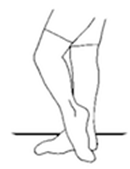 Converting to a sit-to-stand desk can be costly, clunky, and all around awkward. There are a handful of hurdles keeping you from getting one:
Converting to a sit-to-stand desk can be costly, clunky, and all around awkward. There are a handful of hurdles keeping you from getting one:
- Standing for hours on end can be hard, especially if you’re used to sitting. And many desks are laborious to change.
- They’re expensive and not all companies are willing to provide them for you.
- Those who work from home don’t always have the money or space to accommodate one.
I’m here to show you different ways to create your own standing desk and how to make an existing one more comfortable.
-
Make Your Own
 There are a handful of options for adjusting the height of your computer. I recently just bought this little beauty on Amazon for about $50. I cannot tell you how much it’s worth to me! Especially if you have a home office, this is an easy investment. Remember that no work gets done if you’re too broken to work! It’s adjustable a bunch of ways and comes in a variety of colors.
There are a handful of options for adjusting the height of your computer. I recently just bought this little beauty on Amazon for about $50. I cannot tell you how much it’s worth to me! Especially if you have a home office, this is an easy investment. Remember that no work gets done if you’re too broken to work! It’s adjustable a bunch of ways and comes in a variety of colors.Figure 1. Examples of Homemade standing desks Don’t want to spend a single penny on another office supply? Simply stack things, like books, on the desk. Nail four pieced of wood together into a box, place box on the desk, put the computer on the box. It’s that easy! Need a place for your keyboard and mouse? Make a smaller box in the same manner, place in front (or inside) the other box. If you use your imagination it’s really simple to create your own standing workstation. It might also help you declutter your desk by eliminating scattered papers all over the place!
-
Use a tall stool
My favorite trick for any S-T-S desk is to use a bar stool. No one can stand for 8 hours without a break, and you shouldn’t! The largest S-T-S desks use a crank or buttons to move up and down and can take too long, especially if you only want to sit for a short break. Insert the bar stool. You can perch on the stool giving your tired dogs a break quickly and easily. It also eliminates the shortened hip flexors and rounded low back, two of the poor habits of regular sitting.
You can also put the stool under your desk and rest one foot on the rungs (See #4 Vary Your Stance). -
Stand on an unstable surface

Figure 2. Reebok Balance Board Cement is not our friend, standing on it for 8 hours can have negative effects on our body. Just like the checkers at the grocery store, find a more comfortable surface to stand on. Fold up a yoga mat, buy a balance mat off Amazon, anything that’s cushy. I had one patient who after using a balance board (Fig.2) in the clinic bought one and uses it at his desk. He gets to improve his balance, exercise his foot and calf muscles, and get work done all at the same time! Brilliant.
-
Vary Your Stance

Figure 3. Staggered Stance One of the problems with sitting at work is the static nature of 8 hours in one position. The same can be true for standing! To avoid this pitfall, change up your stance. You don’t have to be “that guy that does squats at his desk”, it can be as simple as changing your foot placement:
- Wide stance: Feet really far apart, at least wider than your hips

Figure 4. Shin Stretch - Staggered stance: One foot in front of the other, then switch (Fig.3)
- Raise one foot: place one foot on a small riser, maybe some books, whatever you’ve got! Be sure to alternate feet
- Heel-toe rocks: rock your weight onto your heels then onto the balls of your feet, go back a forth continuously.
- Calf raises: raise up onto the balls of your feet and slowly lower back down. Raise up as high or low as you want.
- Shin stretch: Tuck your toes under (Fig.4) feel a slight stretch in the front of your foot, ankle, and/or shin. Hold for at least 30 seconds on each side.
- Wide stance: Feet really far apart, at least wider than your hips
-
Tighten and Tone Your Muscles
You can improve your posture by using tension throughout the day. I don’t mean flexing, I mean creating tension:
- Screw your feet into the ground. With feet pointed straight forward, pretend they are glued to the floor and create tension twisting them out away from each other. They shouldn’t actually move, but you’ll feel your glutes, quads, and other muscles kick in with some tension. Hold as long as you can!
- Twist your kneecaps out. Similar to screwing your feet in the ground, the feet shouldn’t move as you create tension by turning your kneecaps away from each other. If this irritates your knees at all just stick with screwing the feet.
- Squeeze your butt. Bring your hips forward toward your desk and squeeze your butt. It doesn’t have to be a 150% effort squeeze, just 50% will do right now.
- Tighten your abs. Pretend someone is going to punch you in the stomach, or a linebacker is headed your way. You would brace by tightening your entire core, front to back and side to side. DO NOT suck in your stomach! This doesn’t work the muscles, it just squishes your organs.
- Stand SUPER tall. Pretend you’re 10 years old and your mom is measuring your height against the wall. Remember how you used to push up really tall through your heels, elongating your neck and spine? Do that. Push the crown of your head up as high as you can, feeling lift come from your midsection. Holding this has great benefits to your muscles as well as spinal discs, preventing things like joint degeneration and disc bulging. Ideally, you would stand like this all the time, so do it as much as you can.
Exercises You Can Do at Home after a Visit to the Chiropractic Clinic
Stay active at home with exercises from ‘Exercises You Can Do at Home after a Visit to the Chiropractic Clinic’.
Read MoreAthletic Therapy: A Vital Component in Sports Rehabilitation
Discover the importance of athletic therapy in sports rehabilitation in our insightful blog on ‘Athletic Therapy: A Vital Component in Sports Rehabilitation’.
Read MoreA Comprehensive Guide to Spinal Therapy for Athletes
Discover the benefits of spinal therapy for athletes in our comprehensive guide ‘A Comprehensive Guide to Spinal Therapy for Athletes’.
Read MoreHow Chiropractic Techniques are Advancing in Pain and Injury Treatment
Discover the latest advancements in pain and injury treatment through innovative chiropractic techniques.
Read MoreSpine Rehabilitation: How Corrective Exercises Can Help with Posture and Pain Relief
Discover how corrective exercises in spine rehabilitation relieve pain and improve posture – read more now!
Read MoreCorrective Exercises: Your Secret Weapon Against Chronic Pain
Combat chronic pain with corrective exercises featured in ‘Corrective Exercises: Your Secret Weapon Against Chronic Pain’.
Read More
 There are a handful of options for adjusting the height of your computer. I recently just bought this little beauty on Amazon for about $50. I cannot tell you how much it’s worth to me! Especially if you have a home office, this is an easy investment. Remember that no work gets done if you’re too broken to work! It’s adjustable a bunch of ways and comes in a variety of colors.
There are a handful of options for adjusting the height of your computer. I recently just bought this little beauty on Amazon for about $50. I cannot tell you how much it’s worth to me! Especially if you have a home office, this is an easy investment. Remember that no work gets done if you’re too broken to work! It’s adjustable a bunch of ways and comes in a variety of colors.






